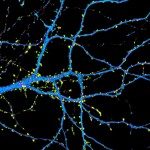Link to Pubmed [PMID] – 19111597
Brain Res. Bull. 2009 Mar;78(6):283-9
Elevated brain monoamine concentrations resulting from monoamine oxidase A genetic ablation (MAOA knock-out mice) lead to changes in other neurotransmitter systems. To investigate the consequences of MAOA deficiency on the cholinergic system, we measured ligand binding to the high-affinity choline transporter (CHT1) and to muscarinic and nicotinic receptors in brain sections of MAOA knock-out (KO) and wild-type mice. A twofold increase in [(3)H]-hemicholinium-3 ([(3)H]-HC-3) binding to CHT1 was observed in the caudate putamen, nucleus accumbens, and motor cortex in MAOA KO mice as compared with wild-type (WT) mice. There was no difference in [(3)H]-HC-3 labeling in the hippocampus (dentate gyrus) between the two genotypes. Binding of [(125)I]-epibatidine ([(125)I]-Epi), [(125)I]-alpha-bungarotoxin ([(125)I]-BGT), [(3)H]-pirenzepine ([(3)H]-PZR), and [(3)H]-AFDX-384 ([(3)H]-AFX), which respectively label high- and low-affinity nicotinic receptors, M1 and M2 muscarinic cholinergic receptors, was not modified in the caudate putamen, nucleus accumbens, and motor cortex. A small but significant decrease of 19% in M1 binding densities was observed in the hippocampus (CA1 field) of KO mice. Next, we tested acetylcholinesterase activity and found that it was decreased by 25% in the striatum of KO mice as compared with WT mice. Our data suggest that genetic deficiency in MAOA enzyme is associated with changes in cholinergic activity, which may account for some of the behavioral alterations observed in mice and humans lacking MAOA.

